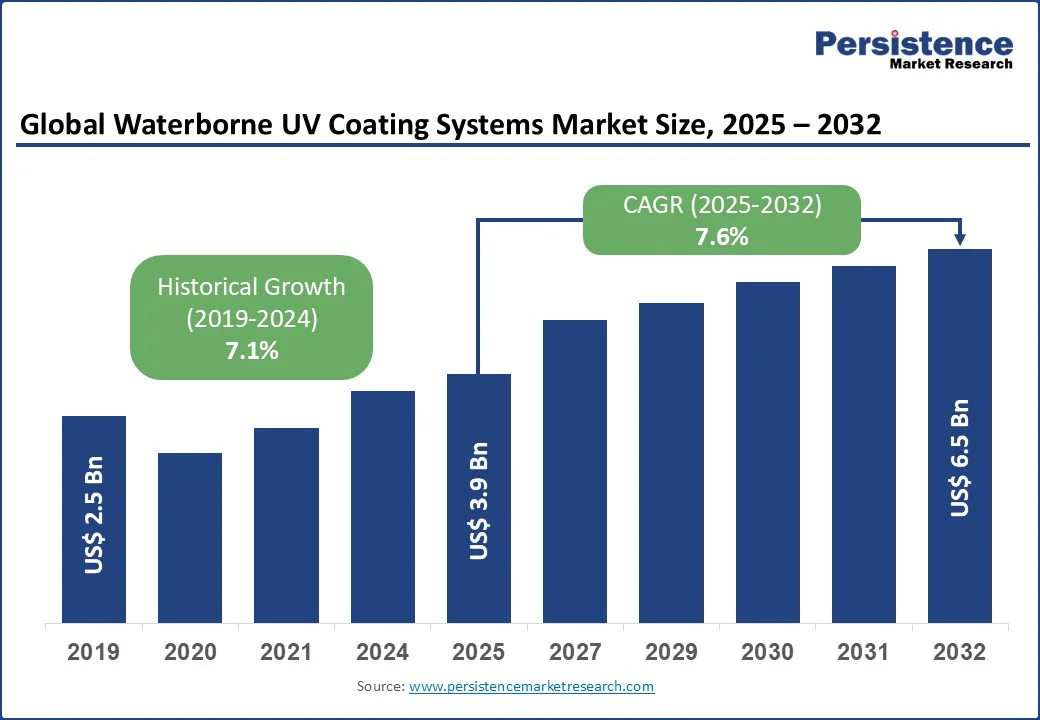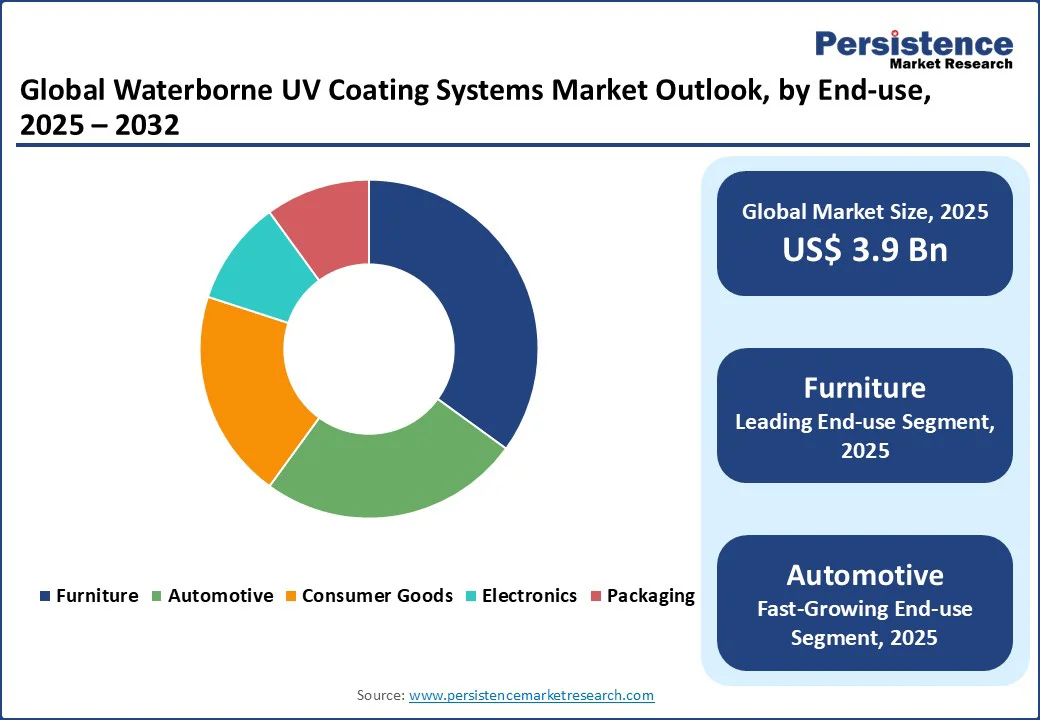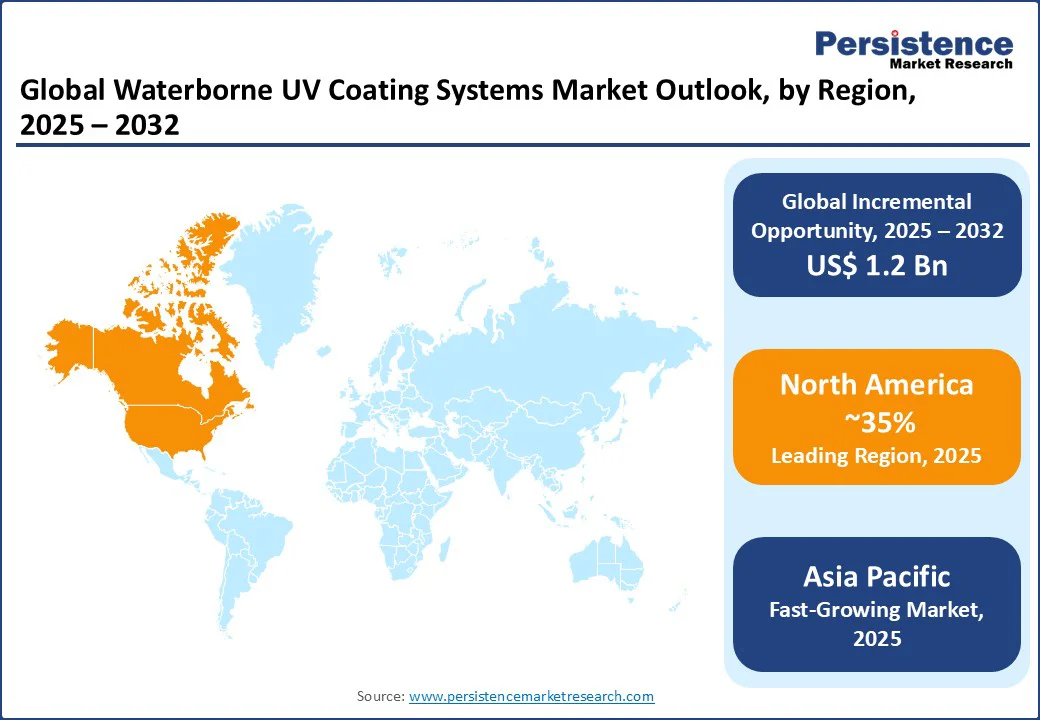ID: PMRREP5204| 193 Pages | 28 Aug 2025 | Format: PDF, Excel, PPT* | Chemicals and Materials

The global waterborne UV coating systems market size is likely to be valued at US$3.9 Bn in 2025 and estimated to reach US$6.5 Bn by 2032, growing at a CAGR of 7.6% during the forecast period 2025 - 2032.
The waterborne UV coating systems industry is experiencing strong growth in 2025, driven by rising demand for eco-friendly and high-performance coating solutions. These systems combine the environmental benefits of water-based formulations with the efficiency of UV curing, significantly reducing VOC emissions and meeting stringent sustainability regulations. With a growing emphasis on sustainable manufacturing and premium-quality finishes, waterborne UV coating systems are increasingly positioned as the preferred choice across various industries.
Key Industry Highlights

|
Global Market Attribute |
Key Insights |
|
Waterborne UV Coating Systems Market Size (2025E) |
US$3.9 Bn |
|
Market Value Forecast (2032F) |
US$6.5 Bn |
|
Projected Growth (CAGR 2025 to 2032) |
7.6% |
|
Historical Market Growth (CAGR 2019 to 2024) |
7.1% |
The waterborne UV coating systems market is propelled by stringent global environmental regulations and rising demand for eco UV coating systems, low-VOC UV coatings, and environmentally friendly coating processes, significantly boosting sustainable UV-curable waterborne coatings market trends. In 2025, regulations such as the EU’s REACH and the U.S. EPA’s VOC limits reduced solvent-based coating usage by 20%, driving adoption of water-based coatings and VOC-compliant coating systems.
Low VOC waterborne UV coatings for automotive parts and high-performance UV coatings for packaging materials saw a 15% demand surge in 2025, due to their low volatile organic compound (VOC) emissions (under 3.5 pounds per gallon of water). Furniture UV coating systems and UV-curable coatings for the packaging industry benefit from 70% lower VOC emissions compared to solvent-based alternatives.
The waterborne UV coating systems market faces a significant restraint due to the high initial costs of UV curing systems and the need for specialized equipment, limiting adoption of water-based coatings and protective coatings. The installation of UV radiation curing systems costs US$ 500,000 to US$ 1 Mn per facility, posing a barrier for small and medium-sized enterprises (SMEs).
Electron beam curing equipment, critical for high-performance UV coatings used in packaging materials, requires an upfront investment of US$2 million. In emerging markets, only 15% of manufacturers adopted eco UV coating systems in 2025 due to cost constraints.
Additionally, 25% of Asian users cited equipment complexity as a barrier, slowing the adoption of industrial surface finishing and furniture UV coating systems. Low-VOC UV coatings require skilled labor for operation, resulting in a 10% increase in training costs.
These challenges hinder the scalability of VOC-compliant coating systems and environmentally friendly coating processes, particularly in cost-sensitive regions, impacting automotive coating solutions and UV-curable coatings for the packaging industry growth.
The waterborne UV coating systems market is poised for growth due to increasing opportunities in emerging markets and advancements in coating technology, particularly UV curing systems and green coating technologies.
The Asia Pacific region, with a projected 40% increase in the construction and automotive sectors by 2025, drives demand for low-VOC waterborne UV coatings for automotive parts and furniture UV coating systems. China and India allocated US$ 50 Bn to sustainable manufacturing in 2025, boosting industrial coatings and protective coatings.
Sustainable UV-curable waterborne coatings market trends show a 12% growth in packaging applications, driven by e-commerce and high-performance UV coatings for packaging materials. Advancements in UV radiation curing, such as high-intensity LED emitters, reduce curing times by 25%, enhancing environmentally friendly coating processes.
Nanovere Technologies reported 15% growth in nanotechnology-based low-VOC UV coatings in 2025. Emerging markets, such as India, with a 20% rise in industrial surface finishing demand, offer opportunities for eco-UV coating systems. These trends, supported by VOC-compliant coating systems, position the market for sustained expansion in the automotive, furniture, and electronics sectors.
Acrylic-based Coatings hold a 40% market share in 2025, driven by their versatility in industrial coatings and low-VOC UV coatings. With 35% adoption in automotive coating solutions and furniture UV coating systems in 2025, acrylics offer excellent UV resistance and durability.
Their dominance stems from green coating technologies and environmentally friendly coating processes. Urethane-based Coatings are fueled by demand for protective coatings in UV-curable coatings for packaging industry. With 12% growth in 2025, urethanes excel in industrial surface finishing due to superior scratch resistance.
Wood Coatings command a 35% market share in 2025, driven by furniture UV coating systems. With 40% adoption in furniture manufacturing in 2025, wood coatings benefit from low-VOC UV coatings and UV waterborne finish for aesthetic appeal. These coatings offer superior surface protection, enhanced resistance to scratches, and long-lasting gloss, making them ideal for high-quality wood products.
Plastic Coatings are fueled by demand in UV-curable coatings for the packaging industry. With 15% growth in 2025, plastic coatings support environmentally friendly coating processes in consumer goods. The packaging industry’s demand for rapid production cycles and energy-efficient processes further strengthens the market for these coatings. Moreover, plastic coatings contribute to improved printing and labeling performance, which is essential for brand visibility and product differentiation.
UV radiation curing holds a 50% market share in 2025, driven by its efficiency in coating technology. With 60% adoption in industrial surface finishing in 2025, it supports low-VOC waterborne UV coatings for automotive parts. UV radiation curing ensures a hard, scratch-resistant finish, improving the longevity and visual quality of coated surfaces. Additionally, its energy efficiency and ability to operate at lower temperatures make it ideal for heat-sensitive substrates.
Hybrid curing is fueled by advancements in green coating technologies. With 10% growth in 2025, hybrid curing enhances high-performance UV coatings for packaging materials. By offering energy efficiency and compatibility with eco-friendly raw materials, hybrid curing meets the dual need for sustainability and advanced functionality. Its ability to integrate seamlessly into existing production lines without extensive modifications further strengthens its adoption across packaging and industrial sectors.
Furniture holds a 30% market share in 2025, driven by furniture UV coating systems. With 35% adoption in 2025, furniture benefits from UV waterborne finish and low-VOC UV coatings. These coatings deliver superior benefits, including faster curing times, exceptional resistance to scratches and stains, and long-lasting gloss, making them ideal for wooden furniture and decorative items. The shift toward sustainable interior design and premium-quality furniture has further accelerated the demand for these coatings.
Automotive is fueled by low-VOC waterborne UV coatings for automotive parts. With 12% growth in 2025, automotive coatings support industrial surface finishing. The adoption of UV coatings in automotive manufacturing supports efficient industrial surface finishing, enabling faster curing times and reduced energy consumption compared to conventional methods. This efficiency is critical for high-volume automotive production, where reducing cycle time directly impacts overall productivity.

North America holds a 35% global market share in 2025, with the U.S. leading due to advanced coating technology and industrial coatings infrastructure, generating US$1.36 Bn in sales in 2025. The U.S. market grows at a CAGR of 7.8%, driven by low VOC waterborne UV coatings for automotive parts, with 60% of automotive manufacturers adopting VOC-compliant coating systems in 2025.
Axalta Coating Systems holds a 15% regional share, leveraging industrial surface finishing. A 20% increase in sustainable manufacturing investments in 2025 boosts eco UV coating systems and protective coatings.
Europe accounts for a 30% global share, led by Germany, the UK, and France. Germany’s market grows at a CAGR of 7.5%, driven by furniture UV coating systems, with 50% of furniture exports using low-VOC UV coatings in 2025.
The UK sees 10% growth in high-performance UV coatings for packaging materials, supported by green coating technologies. France’s automotive coating solutions drive 8% growth, with Bayers MaterialScience leading. EU regulations reduced VOC emissions by 15% in 2025, boosting environmentally friendly coating processes.
Asia Pacific is the fastest-growing region, with a CAGR of 8.2%, led by China, Japan, and India. China holds a 40% regional share, driven by US$20 Bn in manufacturing investments in 2025, boosting UV-curable coatings for the packaging industry.
India’s market is fueled by 20% growth in industrial surface finishing. Japan’s coating technology advancements drive 10% growth in electronics, with Sirca SpA expanding. Sustainable UV-curable waterborne coatings market trends and eco UV coating systems fuel regional growth.

The global waterborne UV coating systems market is competitive, with Bayers MaterialScience, Axalta Coating Systems, Nanovere Technologies, Becker Coatings, and Sirca SpA focusing on coating technology, low-VOC UV coatings, and industrial coatings. Companies leverage green coating technologies and environmentally friendly coating processes to gain market share.
Strategic R&D investments in UV curing systems and partnerships drive sustainable UV-curable waterborne coatings market trends, addressing automotive coating solutions and furniture UV coating systems.
The waterborne UV coating systems market is projected to reach US$ 3.9 Bn in 2025, driven by low-VOC UV coatings and eco UV coating systems.
Stringent environmental regulations and a 20% reduction in solvent-based coatings in 2025 fuel demand for environmentally friendly coating processes.
The waterborne UV coating system market grows at a CAGR of 7.6% from 2025 to 2032, reaching US$ 6.5 Bn by 2032.
Emerging markets and 25% faster curing times from UV curing systems advancements drive sustainable UV-curable waterborne coatings market trends.
Key players include Bayers MaterialScience, Axalta Coating Systems, Nanovere Technologies, Becker Coatings, and Sirca SpA.
|
Report Attribute |
Details |
|
Historical Data/Actuals |
2019 - 2024 |
|
Forecast Period |
2025 - 2032 |
|
Market Analysis Units |
Value: US$ Bn, Volume: As Applicable |
|
Geographical Coverage |
|
|
Segmental Coverage |
|
|
Competitive Analysis |
|
|
Report Highlights |
|
|
Customization and Pricing |
Available upon request |
By Product Type
By Application
By Technology
By End-use
By Region
Delivery Timelines
For more information on this report and its delivery timelines please get in touch with our sales team.
About Author